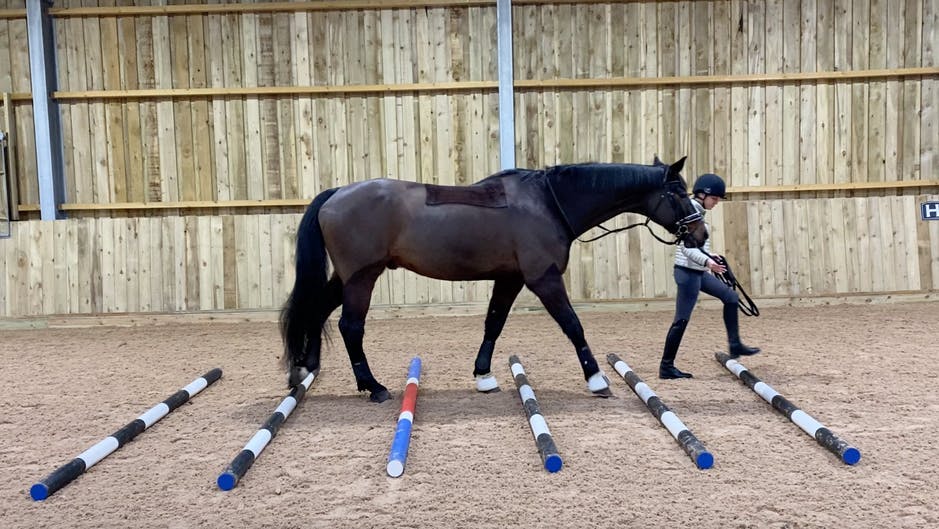Perfect Pole Work
A Fun Exercise for You and Your Horse.
Posted Jan 26, 2022 · Updated Mar 25, 2022.

Maddie Wigley · 4 minute read.
Cavaletti poles are a useful training tool due to their role in making joints more supple and improving the individual’s stamina and muscle tone. Advantages of cavaletti work include minimising the incidence of injuries, improving performance for competitions, delaying the onset of fatigue, maintaining willingness, and improving skills and work capacity. Poles should be set up with a rough distance of 3-3.5 feet between them for walk poles and then 4-4.5 feet apart for trot poles to ensure the distance between the poles fits the individuals stride length. The horse should initially be walked, in hand, over the walk poles and this should be done both ways. Poles can be adjusted from this so they are further apart, as trot poles, and the horse can be trotted in hand over the poles; again, making sure to do this in both directions. Cavaletti poles should gradually be increased in difficulty, but they shouldn’t be overused as this can lead to injury. They can be made more challenging by raising them, starting with raising one end at a time and initially progressing to both ends raised. This can also be done at walk and trot and then with a rider on top.

Pole work enables the horse to use its limbs more and increase the demand through the legs without compromising the horse’s gait. The horse is encouraged to move rhythmically and to swing through their backs. Muscles can be built up using poles as the horse is asked to work in a controlled way and they are encouraged to flex their limbs to lift their feet above the poles which requires core engagement. Poles aid recovery as they release muscle tension. This works as they encourage a low neck that is stretched forwards and down which causes back muscles, such as the longissimus dorsi, to contract and relax thus reducing tightness.
A study by Shaw et al., 2021, analysed the effect of ground poles on the longissimus dorsi and rectus abdominus muscle activity during walk and trot. This study showed that walking over poles drastically increased bilateral muscle activity in these two muscles. It also highlighted how trotting over poles mainly increased activity within the rectus abdominus muscle. By improving performance and biomechanical efficiency of movement in horses, posture control and core engagement are involved. These improvements reduce the load on the limbs which reduces the chance of injuries.
Posture control and spinal positioning are influenced by many muscle groups including hypaxial and epaxial muscles, hindquarter muscles and abdominal core muscles. Pole work involving raised poles has been proven to increase stride length, tracking distance and increase the cross-sectional area of the multifidi muscle. During the swing phase, the individual must be balanced which requires the body and limbs to maintain stability. The study concluded that the use of ground poles within a rehabilitation programme is expected to increase core abdominal activation and recruitment of epaxial muscles.

Another study, by Brown et al., 2014, evaluated the swing phase kinematics of horses when trotting over poles and explained how Cavaletti poles can be used therapeutically to restore full range of motion in limb joints. Pole work has been shown to increase joint flexion which activates and strengthens flexor musculature which also requires neuromotor coordination and proprioceptive awareness to clear the poles. Pole work also requires flexion of the hip joints which determines the range of hindlimb protraction and retraction during both gaits. The study determined that concentric muscular contractions of the fore and hindlimbs are required during the swing phase when a horse trots over poles which involves the elbow, hip, and tarsal joints which highlights the benefit and overall effect this technique has on the horse.
Horses can also be ridden over Cavaletti poles as you can see in these videos which encourages them to work more correctly and engage their hindlimbs more. The addition of a rider to pole work increases the load for the horse and challenges them which also improves neuromotor control and function alongside the physical benefits mentioned.
References
- Brown, S., Stubbs, N., Kaiser, L., Lavagnino, M and Clayton, H. 2014.’Swing Phase Kinematics of Horses Trotting Over Poles’, Equine Veterinary Journal, 47(1), pp. 107-112.
- Klimke, I and Klimke, R. (2018) Cavalletti for Dressage and Jumping. Marlborough: The Crowood Press.
- Paulekas, R and Haussler. 2009. ‘Principles and Practice of Therapeutic Exercise for Horses’, Journal of Equine Veterinary Science, 29(12), pp. 870-893.
- Riber, C., Castejon-Riber, C., Rubio, M., Agüera, E and Muñoz, A. 2017. ‘Objectives, Principles, and Methods of Strength Training for Horses’, Journal of Equine Veterinary Science, 56(1), pp. 93-103.
- Shaw, K., Ursini, T., Levine, D., Richards, J and Adair, S. 2021. ‘The Effect of Ground Poles and Elastic Resistance Bands on Longissimus Dorsi and Rectus Abdominus Muscle Activity During Equine Walk and Trot’, Journal of Equine Veterinary Science, 107(1), pp. 103772.